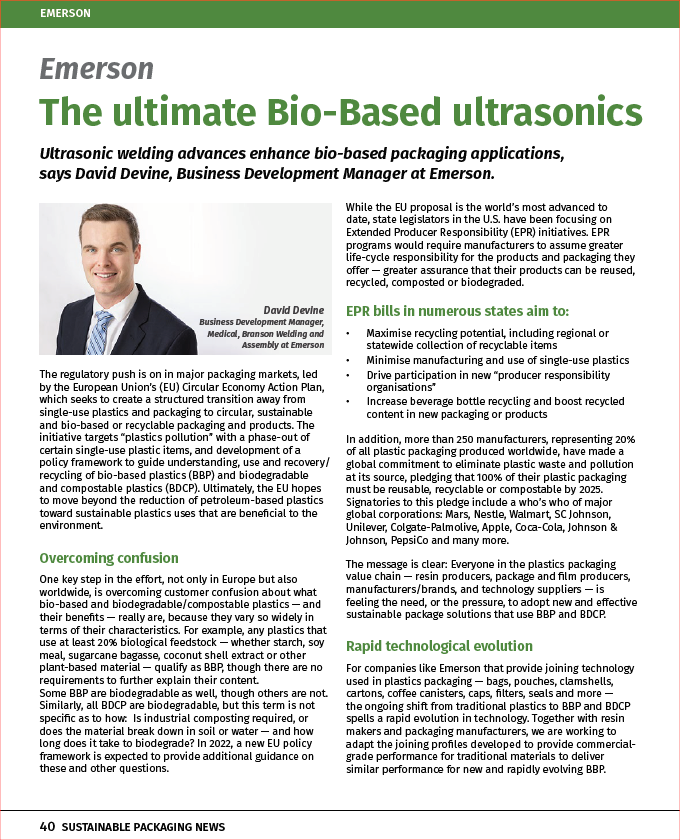If you’re not already familiar with the European Union’s Circular Economy Action Plan, it:
…provides a future-oriented agenda for achieving a cleaner and more competitive Europe in co-creation with economic actors, consumers, citizens and civil society organisations. It aims at accelerating the transformational change required by the European Green Deal, while building on circular economy actions implemented since 2015…
 One area of focus for Europe and other world areas is in packaging materials. In a Sustainable Packaging News article, The ultimate Bio-Based ultrasonics, Emerson’s David Devine shares how Branson Ultrasonic Plastic Welding technology supports the move from single-use plastics packaging to bio-based plastics (BBP) and biodegradable & compostable plastics (BDCP).
One area of focus for Europe and other world areas is in packaging materials. In a Sustainable Packaging News article, The ultimate Bio-Based ultrasonics, Emerson’s David Devine shares how Branson Ultrasonic Plastic Welding technology supports the move from single-use plastics packaging to bio-based plastics (BBP) and biodegradable & compostable plastics (BDCP).
David opens by describing the complexities and in flux regulatory requirements surrounding BBP and BDCP packaging.
For example, any plastics that use at least 20% biological feedstock — whether starch, soy meal, sugarcane bagasse, coconut shell extract or other plant-based material — qualify as BBP, though there are no requirements to further explain their content.
One thing is clear.
Everyone in the plastics packaging value chain — resin producers, package and film producers, manufacturers/brands, and technology suppliers — is feeling the need, or the pressure, to adopt new and effective sustainable package solutions that use BBP and BDCP.
Emerson as a supplier of packaging joining technology:
…used in plastics packaging — bags, pouches, clamshells, cartons, coffee canisters, caps, filters, seals and more — the ongoing shift from traditional plastics to BBP and BDCP spells a rapid evolution in technology.
The challenge in these materials is that:
…bio-based plastics contain less polymer, process at lower temperatures, and have a “narrower” processing window. There is a much smaller difference between the temperatures at which bio-based plastics melt and seal effectively and those at which they begin to degrade and lose strength or seal integrity.
Ultrasonic welding can address this challenge as an alternative to traditional thermal sealing technology.
Ultrasonic welding not only offers far more sensitive and responsive process control but also generates heat to create the seal in a much different way. Thermal sealers drive high heat from the outside in, through the plastic layers, to the seal interface. Ultrasonic welders use high-frequency vibration to create frictional heat within the plastic-to-plastic interface. This “insideout” melt seal focuses heat at the seal interface — where it is needed most.
Read the article for more as David highlights these challenges around the emerging sustainable packaging regulatory requirements, and how suppliers like Emerson are working with global packaging producers to address these requirements to deliver safe and effective sealing.
Visit the Branson Ultrasonic Plastic Welding section on Emerson.com for more on the technologies and products to provide effective sealing for your packaging operations.





